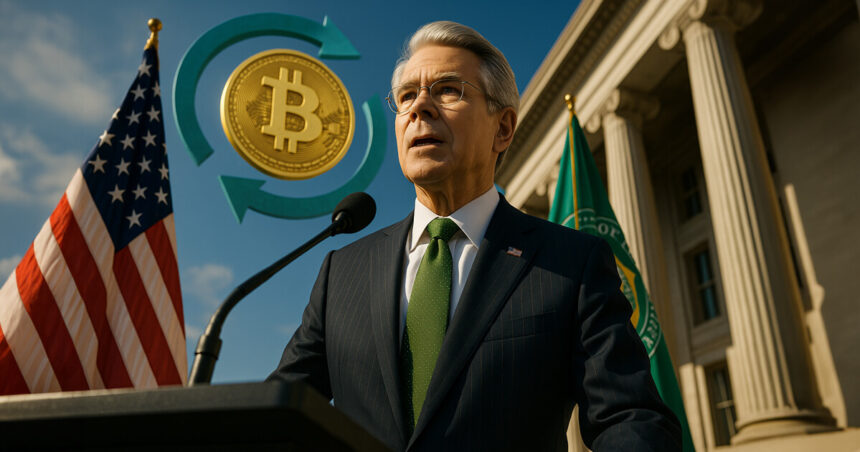
For the first time, a sitting US Treasury secretary has described Bitcoin as more than just a speculative frenzy. Scott Bessent’s post didn’t just set Crypto Twitter on fire. This has led to a major shift in how policymakers view the number one cryptocurrency. It’s a far cry from the days when Bitcoin lurked in the margins, under constant attack from regulators as the favorite tool of nefarious actors. Best post:
“17 years after the White Paper, the Bitcoin network is still up and running and more resilient than ever. Bitcoin will never shut down. @SenateDems could learn something from it.”
Bitcoin tipping point in Washington
Until recently, the mainstream narrative of DC pegged Bitcoin and the broader crypto market as a regulatory headache. It was a threat to financial stability and, at best, a glittering casino for retail maniacs and anarchists. “Operation Chokepoint 2.0”, as any crypto industry veteran will tell you, was more of an orchestrated campaign than a conspiracy.
Banks quietly cut ties with exchanges. Startups were struggling to secure basic compliance services. For some time now, the message from the top has been clear: Digital assets are not welcome at America’s money table.
So the Treasury Secretary calling Bitcoin a system that governments should learn from rather than suppress was a headline that would have sounded like satire last year. More than that, it is widely recognized that Bitcoin is more than just a financial play. This is critical U.S. infrastructure that is always on.
Why the support of the Treasury Secretary is important
Bessent is rewriting the official script by calling attention to Bitcoin’s uptime and resilience. This isn’t about price volatility or ransomware headlines. Far from it. Instead, this is a subtle admission: Bitcoin is something the United States can learn from, not just regulate and subjugate.
The alliance with Senate Democrats was no coincidence either. The legislative impasse over policy is relentless. The US government was shut down for an entire month. That’s something you can never do with Bitcoin. The network has powered up, processed transactions, crossed borders, weathered bear markets and proven itself block by block despite political storms.
Of course, the Bitcoin community was proportionately euphoric over Bessent’s post. Hunter Horsley, CEO of Bitwise, commented:
“Are you bearish? See below. In 2025, Bitcoin will become mainstream.”
Bitcoin advocate and investor Mark Moss responded:
“This is how America leads! Let’s go!”
But what’s strange is the context of this post. The mood on crypto Twitter is perhaps more bearish than ever. Bitcoin’s price may be hovering around $110,000, but the “Uptober” hardly brought the upside investors were hoping for.
Analyst Will Clemente commented:
“The atmosphere in the crypto group chats I’m in is honestly sad. People have completely given up and haven’t pivoted to other asset classes yet. Everyone seems fed up, depressed, and defeated. How can you blame them given how BTC has been trading this year?”
Social sentiment, Altmania, meme coins, BTC, RWA, none of them are exciting. And yet, here’s the Treasury Secretary praising Bitcoin.
Regulatory hurdles are being removed. Big bucks finally started showing up with orders. The market structure is maturing by the week, and blue-chip companies are quietly accumulating capital.
The market is changing. Retail and Bitcoin OGs are giving way to institutional investors. Bitcoin has matured as an asset class and is no longer subject to wild price swings like in the past, when posts like this one from the US Treasury Secretary would have sent BTC prices back on track.
From chokepoints to infrastructure
Despite the prevailing gloom, the importance of Mr. Bessent’s statement and this strange time for Bitcoin cannot be overstated. For most of Bitcoin’s history, its very existence has been viewed as a threat by authorities. It was to monitor, restrain, conceal, or at least subjugate. Now, Treasury officials defending their resilience and touting the system’s transparency and uptime is more than just a bullish signal. It’s an invitation.
Washington could still bicker and the narrative would continue to be flogged. But one thing is clear: After years of shadowboxing, the US is finally taking Bitcoin off its blacklist and bringing it head-on into the infrastructure conversation. As policymakers scramble for answers, it may be time to really, really learn something from the network that “never shuts down.”
(Tag translation) Bitcoin


